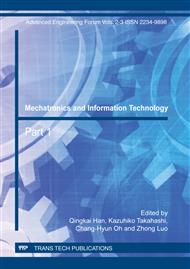p.269
p.273
p.277
p.281
p.285
p.291
p.296
p.302
p.308
Research on Dynamic Characteristics of Serial-Parallel Combination Joint with Flexible-Cable
Abstract:
In order to design the humanoid dual-arms high voltage transmission line inspection robot, the robot model is given and the working mechanism of the robot crossing obstacles is introduced, and the motion trajectory of the robot when it is moving is analyzed. The dynamic equations of the serial driven and the serial-parallel driven robotic arm are presented based on Lagrange equation and the dynamic characteristics of the wrist and elbow joint are simulated. The numerical simulation result of the serial driven robotic arm shows that the elbow joint has great torque when the robot moves horizontally and vertically. However, the numerical simulation result of the serial-parallel driven robotic arm shows that the elbow joint torque reduces greatly comparing with the serial driven arm. By analyzing the results of the simulation experiment, it can be seen that this serial-parallel combination driven joint with flexible-cable can reduce the elbow torque greatly and improve the load capacity of robotic arm comparing with the serial driven joint, which can solve the problem that the torque of serial driven joint in dual-arms inspection robot is too high.
Info:
Periodical:
Pages:
285-290
Citation:
Online since:
December 2011
Authors:
Keywords:
Permissions:
Share:
Citation:


